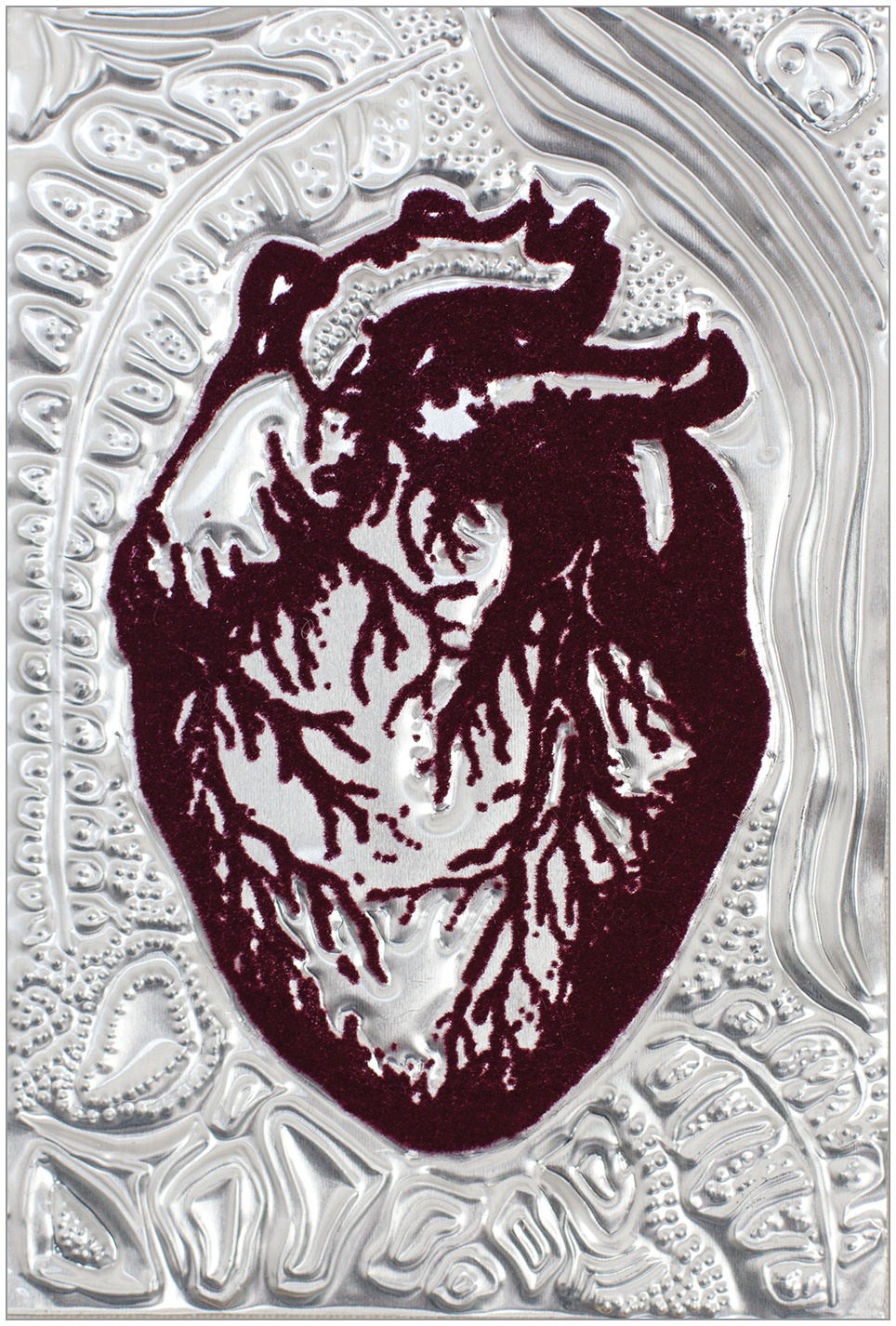Our official English website, www.x-mol.net, welcomes your feedback! (Note: you will need to create a separate account there.)
Beyond Heart Symbolism: Artistic Representation of Narratives of Congenital Heart Disease
JAMA ( IF 120.7 ) Pub Date : 2017-11-14 , DOI: 10.1001/jama.2017.14285 Giovanni Biglino 1 , Sofie Layton 2 , Jo Wray 3
JAMA ( IF 120.7 ) Pub Date : 2017-11-14 , DOI: 10.1001/jama.2017.14285 Giovanni Biglino 1 , Sofie Layton 2 , Jo Wray 3
Affiliation

|
The heart is an organ charged with extraordinary symbolic value featured in art across time. Contemporary clinically rooted representations of the heart have appeared recently in UK exhibits by fashion and portrait photographer Kirsty Anderson, who mounted a photograph display of patients with congenital heart disease (CHD) at Kelvingrove Art Gallery and Museum in Glasgow accompanied by first-person stories relating to each portrait; and by artists Tim Wainwright and John Wynne, who employed photography, film, and sound to recount the experience of transplantation and organ donation at the Hunterian Museum in London. In both cases, the voice of the patient was an integral component of the artwork itself. Here we describe how a participatory arts practice led to co-creating original artwork incorporating the voice of patients and families. With Heart Narratives, a 165 × 85-cm wall-mounted panel, British artist Sofie Layton aimed to represent the language and narrative of CHD. Layton was artist in residence in 2015-2016 at Great Ormond Street Hospital for Children in London. On the hospital ward or through creative workshops,2 the artist worked with families and medical personnel treating CHD to explore imagery and to develop a visual representation of their narratives of illness. Participants included children with CHD (adolescents with repaired defects, including transposition of the great arteries, tetralogy of Fallot, and hypoplastic left heart syndrome); parents of newborns or infants on pediatric cardiac wards with diagnoses of hypoplastic left heart syndrome and DiGeorge syndrome; and researchers and practitioners. The panel is composed of equally spaced A6-sized metal plates (either copper or aluminum), screen-printed with a heart image in a range of colors and sizes. As part of the process, participants were invited to choose a plate that most resonated with them in terms of material and color, and they then embossed it with elements directly relating to their narrative. Small images delicately embossed around a central velvet-flocked heart thus become symbols for ambitions, memories, desires, and states of being. Shining suns, whirling spirals, spinach leaves, brick walls, the stripes of a tiger— they all tell stories. Burning flames speak of aspirations and resilience in adolescents that grow up with CHD. A spinach leaf tells a story of acceptance that a favorite food cannot be eaten because of anticoagulant medication. And interposed between these stories, the artist has placed direct quotes from conversations that took place on the ward or during workshops—very few, yet resonating, words: “My new heart is red and it pumps”; “My daughter was born with half a heart”; “My heart is a soldier, it’s been through wars but it’s still fighting, and I am really proud of it.” The result is less confrontational than an approach that may use a medium like photography to directly document or represent the effect of living with CHD. But it is the experiential component that shines (literally)—stories that have been collected and represented by an artist who effectively becomes a conduit for the stories themselves. Detail of a metal plate embossed by a patient with congenital heart disease. A spinach leaf represents food that cannot be eaten because of anticoagulant medication. Image courtesy of George Eksts. Reproduced with permission.
中文翻译:

超越心脏象征主义:先天性心脏病叙事的艺术表现
心脏是一个具有非凡象征价值的器官,在跨越时间的艺术中具有特色。现代临床根植于心脏的表现最近出现在时尚和肖像摄影师 Kirsty Anderson 的英国展览中,他在格拉斯哥的 Kelvingrove 艺术画廊和博物馆展示了先天性心脏病 (CHD) 患者的照片,并附有第一人称的故事。每幅肖像;以及艺术家 Tim Wainwright 和 John Wynne,他们利用摄影、电影和声音在伦敦亨特博物馆讲述了移植和器官捐赠的经历。在这两种情况下,患者的声音都是艺术品本身不可或缺的组成部分。在这里,我们描述了参与式艺术实践如何导致结合患者和家属的声音共同创作原创艺术作品。英国艺术家 Sofie Layton 用 165 × 85 厘米的壁挂式面板 Heart Narratives 旨在代表 CHD 的语言和叙事。2015-2016 年,雷顿是伦敦大奥蒙德街儿童医院的常驻艺术家。在医院病房或通过创意工作坊2,艺术家与治疗冠心病的家庭和医务人员合作,探索图像并开发他们对疾病叙述的视觉表现。参与者包括患有先天性心脏病的儿童(有修复缺陷的青少年,包括大动脉转位、法洛四联症和左心发育不良综合征);诊断为左心发育不良综合征和 DiGeorge 综合征的儿科心脏病房新生儿或婴儿的父母;以及研究人员和从业人员。该面板由等距 A6 尺寸的金属板(铜或铝)组成,丝网印刷有各种颜色和尺寸的心形图像。作为过程的一部分,参与者被邀请选择一个在材料和颜色方面最能引起他们共鸣的盘子,然后他们用与他们的叙述直接相关的元素对其进行浮雕。围绕中心天鹅绒植绒心脏的精致浮雕小图像因此成为野心、记忆、欲望和存在状态的象征。灿烂的太阳、旋转的螺旋、菠菜叶、砖墙、虎纹——它们都在诉说着故事。燃烧的火焰讲述了患有 CHD 的青少年的抱负和韧性。菠菜叶讲述了一个接受抗凝药物不能吃最喜欢的食物的故事。在这些故事之间,艺术家直接引用了发生在病房或工作坊期间的对话——很少,但能引起共鸣:“我的新心是红色的,它在跳动”;“我的女儿天生半颗心”;“我的心是一名士兵,它经历过战争,但仍在战斗,我真的为此感到自豪。” 与可能使用像摄影这样的媒介直接记录或表现患有先天性心脏病的影响的方法相比,结果的对抗性更小。但它是闪耀的体验成分(字面意思)——由艺术家收集和呈现的故事,艺术家有效地成为故事本身的渠道。先天性心脏病患者压印的金属板细节。菠菜叶代表因抗凝药物而不能食用的食物。图片由 George Eksts 提供。经许可转载。
更新日期:2017-11-14
中文翻译:

超越心脏象征主义:先天性心脏病叙事的艺术表现
心脏是一个具有非凡象征价值的器官,在跨越时间的艺术中具有特色。现代临床根植于心脏的表现最近出现在时尚和肖像摄影师 Kirsty Anderson 的英国展览中,他在格拉斯哥的 Kelvingrove 艺术画廊和博物馆展示了先天性心脏病 (CHD) 患者的照片,并附有第一人称的故事。每幅肖像;以及艺术家 Tim Wainwright 和 John Wynne,他们利用摄影、电影和声音在伦敦亨特博物馆讲述了移植和器官捐赠的经历。在这两种情况下,患者的声音都是艺术品本身不可或缺的组成部分。在这里,我们描述了参与式艺术实践如何导致结合患者和家属的声音共同创作原创艺术作品。英国艺术家 Sofie Layton 用 165 × 85 厘米的壁挂式面板 Heart Narratives 旨在代表 CHD 的语言和叙事。2015-2016 年,雷顿是伦敦大奥蒙德街儿童医院的常驻艺术家。在医院病房或通过创意工作坊2,艺术家与治疗冠心病的家庭和医务人员合作,探索图像并开发他们对疾病叙述的视觉表现。参与者包括患有先天性心脏病的儿童(有修复缺陷的青少年,包括大动脉转位、法洛四联症和左心发育不良综合征);诊断为左心发育不良综合征和 DiGeorge 综合征的儿科心脏病房新生儿或婴儿的父母;以及研究人员和从业人员。该面板由等距 A6 尺寸的金属板(铜或铝)组成,丝网印刷有各种颜色和尺寸的心形图像。作为过程的一部分,参与者被邀请选择一个在材料和颜色方面最能引起他们共鸣的盘子,然后他们用与他们的叙述直接相关的元素对其进行浮雕。围绕中心天鹅绒植绒心脏的精致浮雕小图像因此成为野心、记忆、欲望和存在状态的象征。灿烂的太阳、旋转的螺旋、菠菜叶、砖墙、虎纹——它们都在诉说着故事。燃烧的火焰讲述了患有 CHD 的青少年的抱负和韧性。菠菜叶讲述了一个接受抗凝药物不能吃最喜欢的食物的故事。在这些故事之间,艺术家直接引用了发生在病房或工作坊期间的对话——很少,但能引起共鸣:“我的新心是红色的,它在跳动”;“我的女儿天生半颗心”;“我的心是一名士兵,它经历过战争,但仍在战斗,我真的为此感到自豪。” 与可能使用像摄影这样的媒介直接记录或表现患有先天性心脏病的影响的方法相比,结果的对抗性更小。但它是闪耀的体验成分(字面意思)——由艺术家收集和呈现的故事,艺术家有效地成为故事本身的渠道。先天性心脏病患者压印的金属板细节。菠菜叶代表因抗凝药物而不能食用的食物。图片由 George Eksts 提供。经许可转载。


























 京公网安备 11010802027423号
京公网安备 11010802027423号